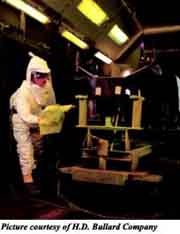Supplied Air Respirators in Automotive Shops: Get the Best Protection
Should Painters Wear Supplied-Air Respirators When Spraying?
Do Air Purifying Respirators Provide Adequate Protection?
Are Supplied-Air Respirators More Expensive Than Air-Purifying Respirators?
Do Supplied-Air Respirators Present Challenges To Auto Refinishing Shop Workers?
How Can I Get More Information On Supplied-Air Respirators?
Should painters wear supplied-air respirators when
spraying?
Yes! It is particularly important to a painter's health towear supplied-air respirators when spraying paints containing highly toxic chemicals such as isocyanates. In fact, paint manufacturers recommend that painters wear supplied-air respiratorsto ensure adequate protection from isocyanate-containing paints. Chemical-protective gloves, clothing, and eye protection are also essential safety equipment for painters.
Note: this guide provides insights into some of the respiratory protection equipment presently available that may be used by auto refinishers. It is not intended to be used as a respirator selection guide.
| WARNING! Isocyanates—a major ingredient in clear coats and many primers—present serious health risks, including asthma, allergic lung and skin reactions, and chronic lung disease. They have even caused painter deaths from asthma reactions. |
back to top | Automotive
Refinishing Partnership Home
Do air-purifying respirators provide painters adequate
protection?
Often no. Although air-purifying respirators or cartridge respirators provide a certain level of protection, supplied-air respirators typically offer greater protection against inhaling toxic chemicals. Further, if cartridges are not changed regularly or not maintained properly, an air-purifying respirator may provide little, if any, protection. Until paints are formulated without toxic chemicals, supplied-air respirators usually offer the best form of respiratory protection.
back to top | Automotive
Refinishing Partnership Home
 Are
supplied-air respirators more expensive than air-purifying respirators?
Are
supplied-air respirators more expensive than air-purifying respirators?
Not necessarily. Some auto refinishing shops have found that the overall cost of a supplied-air respirator system—including initial purchase, installation, and maintenance—is comparable to, or less than, the overall cost of air-purifying respirators, with the continuing expense for organic vapor replacement cartridges.
back to top | Automotive Refinishing Partnership Home
Do supplied-air respirators present challenges to automotive refinishing
shop workers?
Perhaps, but the health benefits of supplied-air systems make the challenges, such as convenience and up-front cost, worth overcoming. Painters have found supplied-air systems that are comfortable, do not hamper visibility, and are easy to put on and take off. Some of the newer models quickly convert to air-purifying respirators for non-spraying activities; others are even air-conditioned! More and more painters are opting for the greater protection of supplied-air respirators—the key is finding the system that's right for you.
back to top | Automotive Refinishing Partnership Home
How can I get more information on supplied-air respirators?
- Talk to painters who use supplied-air systems for first-hand accounts.
- Call your paint supplier, your equipment supplier, or a respirator
manufacturer to learn about the variety of available respirators. Some
of these companies might even offer free demonstrations of their products
at your shop.
- Consult with Mary Cushmac (202-564-8803, cushmac.mary@epa.gov)
or David DiFiore (202-564-8796, difiore.david@epa.gov)
of the DfE Project Team.
back to top | Automotive Refinishing Partnership Home
![[logo] US EPA](https://webarchive.library.unt.edu/eot2008/20090510002240im_/http://www.epa.gov/epafiles/images/logo_epaseal.gif)